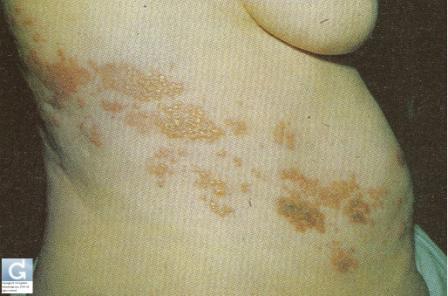What causes shingles ?
- Shingles comes from the latin word cingulum meaning girdle. People who have had chickenpox before can develop herpes zoster, or shingles. The same virus that causes chicken pox, causes shingles. The chickenpox virus remains in a dormant state in certain nerve cells of the body from months to many years, and then reactivates, causing shingles.
- This infection is due to a temporary decrease in the body’s resistance, allowing the virus to start multiplying and to move along nerve fibres towards the skin. The fact that the disease occurs more often in older people is because the immune response is believed to be weaker in older people. Trauma or possibly stress may also contribute to an attack of shingles.
- Immune depressed individuals include those with cancer, eg. leukaemia, lymphoma, those undergoing chemotherapy or radiation therapy for cancer, patients who have organ transplants and are taking drugs to ward off transplant rejection and patients with diseases that effect the immune system eg. AIDS.
What are the symptoms of shingles ?
- The first symptom is a burning pain or tingling and extreme sensitivity in one area of the skin. This may be present for one to three days before a red rash occurs.
- A group of blisters then forms on a red base which looks like chicken pox lesions. The blisters generally last for two to three weeks, during which time they accumulate pus and then crust over and begin to disappear.
- The pain may last longer.
How severe is the pain ?
- The pain is severe enough for the doctor to prescribe pain killers.
- A long-lasting painful complication of shingles called post-herpetic neuralgia occurs in some older patients.
- This may last long after the shingles have healed.
Where do shingles appear on the body ?
- Shingles generally affects only one side of the body.
- Most commonly, blisters will appear on the trunk, including the buttocks and genitalia, or the fact.
- If the blisters involve the eye region, permanent eye damage can result. Your doctor will refer you immediately to an eye specialist when such a complication develops.
What are the complications of shingles ?
- Post-herpetic neuralgia, a condition in which either constant or episodic pain persists for a long time after the skin has healed.
- Infection of the blisters by bacteria can also cause delayed healing of the skin. Antibiotic treatment is needed.
- Another complication is high fever and spread of the disease all over the body.
Is shingles contagious ?
- Shingles is much less contagious than chicken pox.
- People with shingles can spread the virus if blisters are broken and a susceptible person (someone who has never had chicken pox or who is already ill) is close by.
- The people who are at risk include babies and those who already are ill such as cancer patients.
Is there much scarring ?
- Shingles can result in scarring if the blisters are infected or if the patients have used toxic home remedies on the blisters.
How is shingles treated ?
- Shingles clears on its own in a few weeks and seldom recurs. Treatment consists of pain killers, as well as cool compresses to help dry the blisters.
- The antiviral drug, acyclovir, may be given especially for patients with eye involvement or who are very ill.
- This is useful only if it is started early in the disease.
- Acyclovir may occasionally cause headache, some stomach upset and giddiness. The earlier it is taken after the disease begins, the better the effect. The drug might prevent post-herpetic neuralgia.
- Post-herpetic neuralgia can be treated with pain killers and high doses of tranquilisers at night.

Shingles on the flank
Source of information: here




 +41 22 738 18 48
+41 22 738 18 48